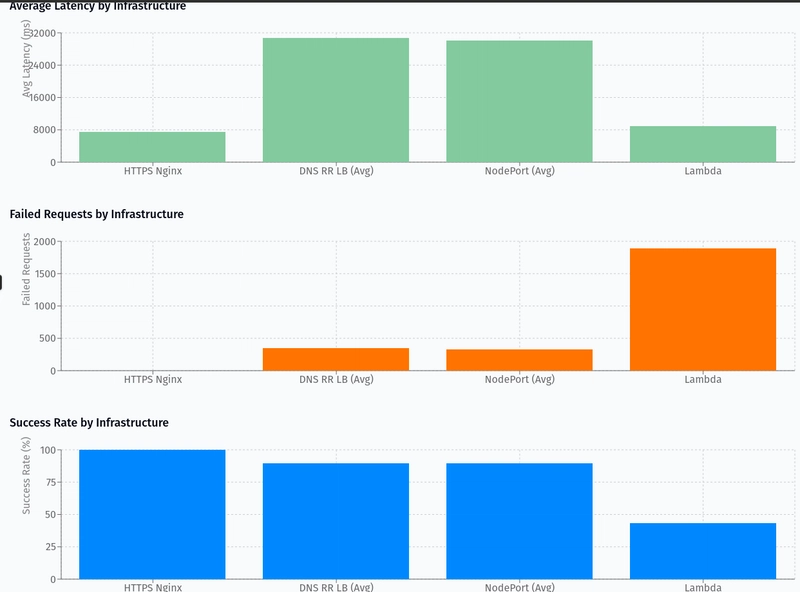Kubernetes Migration: From Lambda to a Cost-Optimized K8s Cluster
Introduction This article documents our journey migrating from AWS Lambda to a self-managed Kubernetes cluster to handle high-concurrency API requests. We'll walk through our motivation, infrastructure choices, implementation details, and most importantly - the performance results that validated our decision. Why Migrate From Lambda? Our original architecture used AWS Lambda behind API Gateway, but we encountered significant limitations: Concurrency Limitations: Our Lambda-based service was unable to handle concurrent executions exceeding 1000 users Poor Performance Under Load: Load testing revealed significant degradation and high failure rates at scale Cost Optimization: We needed to optimize our cost-per-user-served metric Performance Comparison The most compelling argument for our migration comes from the load test results comparing our previous Lambda setup with our new Kubernetes infrastructure options: Key Findings: HTTPS Nginx setup achieved 100% success rate with the lowest average latency (7468ms) at 1100 concurrent users DNS Round-Robin Load Balancer averaged ~89% success rate with varying latency across pods (from 12676ms to 53028ms) NodePort service averaged ~89% success rate with similar latency variance Lambda performed poorly with only 43.48% success rate despite being tested at a lower concurrency (800 users) The visualization clearly demonstrates that our properly configured Nginx + Kubernetes setup significantly outperforms the Lambda architecture, particularly in handling burst traffic and maintaining high success rates.

Introduction
This article documents our journey migrating from AWS Lambda to a self-managed Kubernetes cluster to handle high-concurrency API requests. We'll walk through our motivation, infrastructure choices, implementation details, and most importantly - the performance results that validated our decision.
Why Migrate From Lambda?
Our original architecture used AWS Lambda behind API Gateway, but we encountered significant limitations:
- Concurrency Limitations: Our Lambda-based service was unable to handle concurrent executions exceeding 1000 users
- Poor Performance Under Load: Load testing revealed significant degradation and high failure rates at scale
- Cost Optimization: We needed to optimize our cost-per-user-served metric
Performance Comparison
The most compelling argument for our migration comes from the load test results comparing our previous Lambda setup with our new Kubernetes infrastructure options:
Key Findings:
- HTTPS Nginx setup achieved 100% success rate with the lowest average latency (7468ms) at 1100 concurrent users
- DNS Round-Robin Load Balancer averaged ~89% success rate with varying latency across pods (from 12676ms to 53028ms)
- NodePort service averaged ~89% success rate with similar latency variance
- Lambda performed poorly with only 43.48% success rate despite being tested at a lower concurrency (800 users)
The visualization clearly demonstrates that our properly configured Nginx + Kubernetes setup significantly outperforms the Lambda architecture, particularly in handling burst traffic and maintaining high success rates.











































































































































































![[The AI Show Episode 142]: ChatGPT’s New Image Generator, Studio Ghibli Craze and Backlash, Gemini 2.5, OpenAI Academy, 4o Updates, Vibe Marketing & xAI Acquires X](https://www.marketingaiinstitute.com/hubfs/ep%20142%20cover.png)




























































































































![[DEALS] The Premium Learn to Code Certification Bundle (97% off) & Other Deals Up To 98% Off – Offers End Soon!](https://www.javacodegeeks.com/wp-content/uploads/2012/12/jcg-logo.jpg)


![From drop-out to software architect with Jason Lengstorf [Podcast #167]](https://cdn.hashnode.com/res/hashnode/image/upload/v1743796461357/f3d19cd7-e6f5-4d7c-8bfc-eb974bc8da68.png?#)








































































































.png?#)























.webp?#)










_Christophe_Coat_Alamy.jpg?#)
 (1).webp?#)




































































































![Apple Considers Delaying Smart Home Hub Until 2026 [Gurman]](https://www.iclarified.com/images/news/96946/96946/96946-640.jpg)
![iPhone 17 Pro Won't Feature Two-Toned Back [Gurman]](https://www.iclarified.com/images/news/96944/96944/96944-640.jpg)
![Tariffs Threaten Apple's $999 iPhone Price Point in the U.S. [Gurman]](https://www.iclarified.com/images/news/96943/96943/96943-640.jpg)



































































































































